5:45 am in Australia. I stumble out of bed and slide into my shearling Ugg boots. It’s still dark outside, dawn’s first light just visible through the windows.
My phone is flashing with angry red notification bubbles and unread emails — one of the hazards of living in a time zone where most of your coworkers are at work while you’re asleep — and I need to be vaguely conscious for a Zoom call in 15 minutes.
But first, the frogmouths.
Yes, I said frogmouth. For those unfamiliar with the peculiarities of Australian avifauna, tawny frogmouths are quite possibly the country’s strangest-looking bird. (Although the brushturkeys give them a run for their money.) And two of them happen to roost on my porch railing.
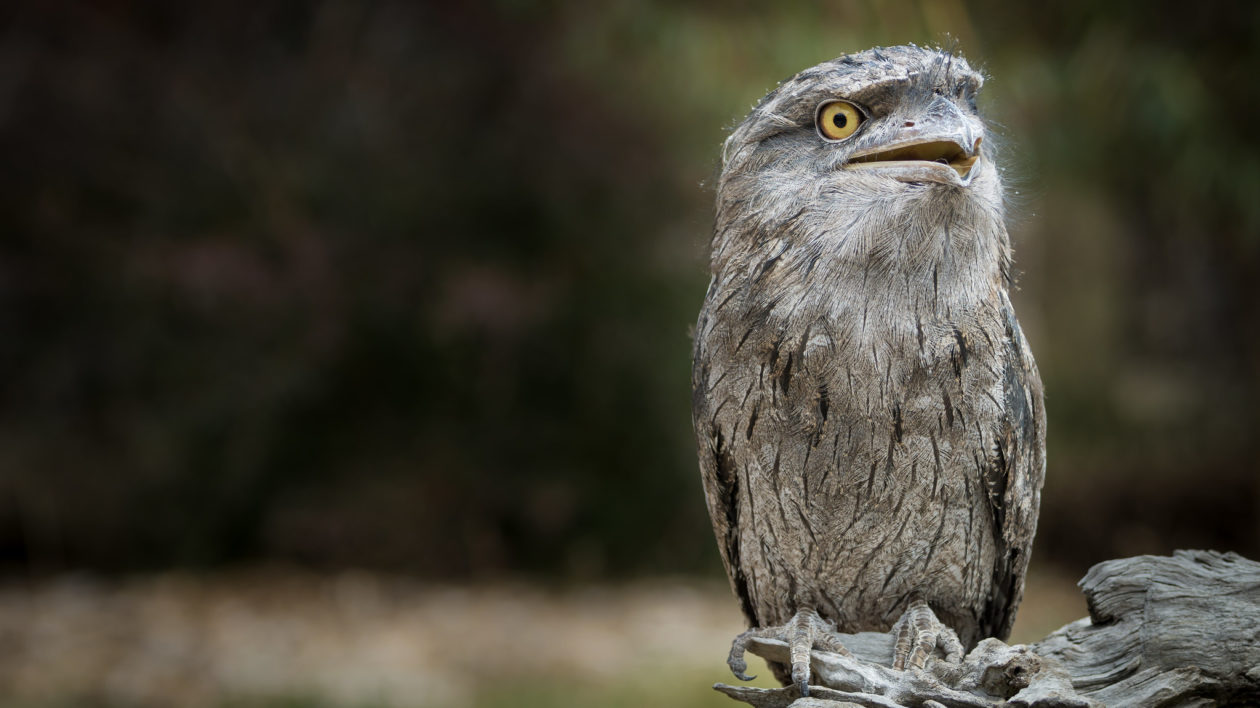
Each morning, before I put the kettle on or open the news to see what fresh hell awaits our pandemic-blighted world, I check on the frogmouths. Two dark forms, hunched down between the wooden balcony railing and my potted palm. They’re my new lockdown obsession.
Though often mistaken for owls, frogmouths are more closely related to nightjars, owlet-nightjars (yes, that’s a real bird), and oilbirds. Perhaps their most famous relative is the potoo, a Central-American species famous for its meme-ready, bulging yellow eyes.
Tawny frogmouths are found throughout Australia in almost all habitat types, from the red and arid outback to suburban backyards. They’re rather large birds, about the size of a barn owl, and like owls they’re nocturnal. During the day, frogmouths perch motionless on a tree branch, often lower down near the center of the trunk.
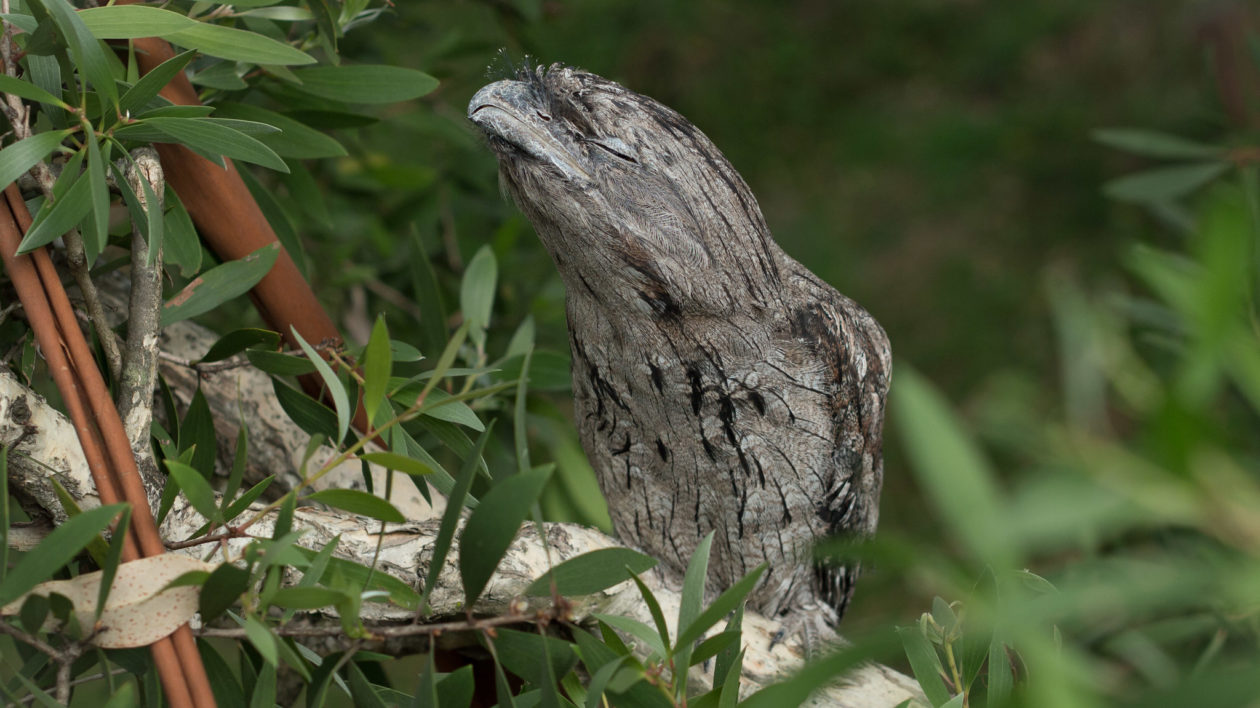
But they’re not always easy to see, because frogmouths have an uncanny ability to imitate trees. Most birds have silver-grey plumage with extensive mottling, black streaks and fine, white barring on their undersides. A second plumage variation is more chestnut toned, and females of both types often have more reddish hues.
I’ve christened my birds Podie (the female) and Striggie (the male), after the species name Podargus strigoides. (And yes, I am one of those people who name their neighborhood wildlife. In case you’re interested, the fat brush-tailed possum is named Waddles and the often-honking male peacock is Honkeytonk Badonkadonk.)
But the frogmouth’s most unforgettable feature is its stare: two massive, bulging yellow eyes staring down at you over a wide, froggish mouth festooned with mustache-like feathers. One second they’re looking at you with baleful indifference, and the next they’re glaring with barely contained fury. Making eye contact with them is an unforgettable experience.
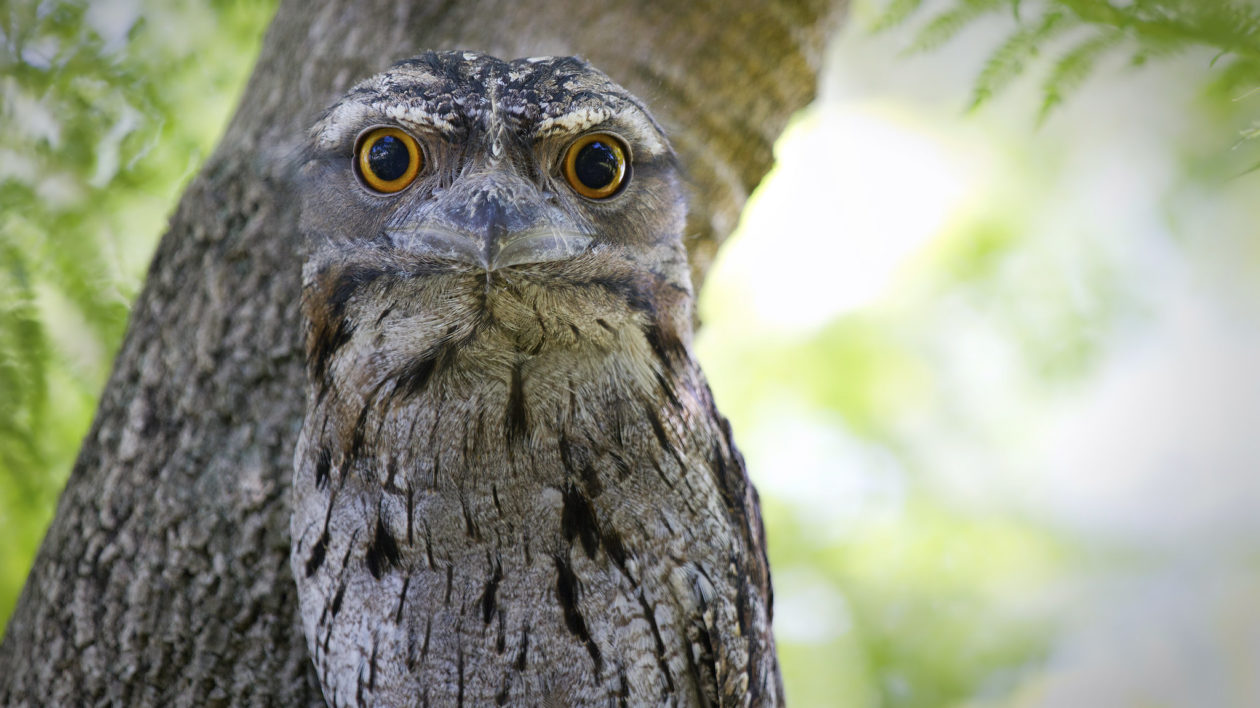
When dusk falls, frogmouths leave their daytime perches to hunt insects, worms, slugs and snails, small mammals, frogs, reptiles, and even small birds. Podie and Striggie depart for their nightly forage, together, at exactly 23 minutes before sunset. I know this because I went on a frogmouth stakeout, glass of wine in hand, one night three weeks into lockdown.
Frogmouths hunt by pouncing from a tree (or other high perch) down to the ground, where they grab prey with their wide beak. (Unlike owls, they have weak feet and lack curved talons for gripping prey.) Scientists suspect that the stiff tuft of feathers at the top of their beak, called rictal bristles, helps them detect flying insects. They will also hunt insects on the wing, and they are frequently hit by cars as they swoop for insects illuminated by headlights.
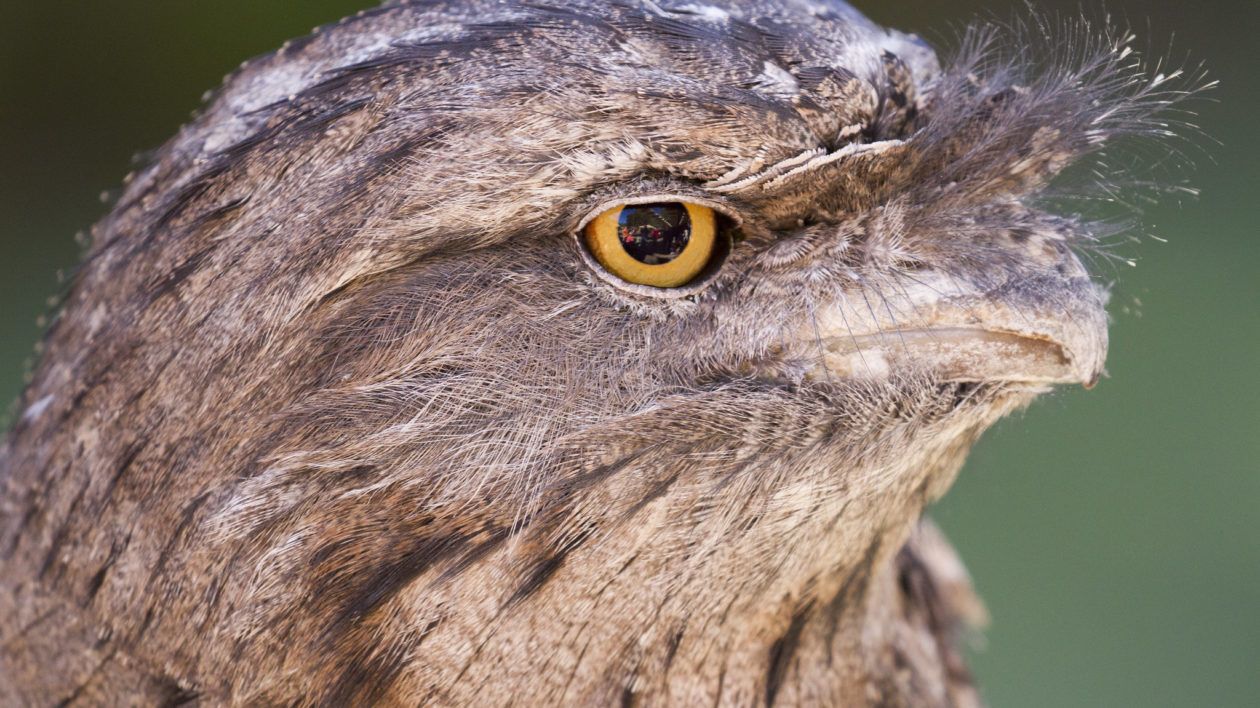
The birds mate for life, and pairs often roost together during the day. My pair is remarkably regular, appearing side by side each morning, day after day. On the rare morning where one of the pair is missing, we alert the neighbors who check the birds’ old roosting spot in their tree, just a few meters away.
Physical contact is key for frogmouths maintaining their bond. Now that winter is closing in, Podie and Striggie are often huddled very close together. Male frogmouths often groom females, preening their feathers as they share their perch, and are typically the more watchful and protective of the pair.
Striggie glares down at me with alarm every time I try to sweep the driveway or weed the front flower bed. When I dare enter the guest bedroom near their perch, he gives me a loathful side-eye. (And God forbid I have to vacuum.)
Meanwhile, Podie is totally nonplussed, dozing away in the sun. When the temperature rises in the late afternoon, both birds open their mouths to help thermoregulate, giving me a peek at their long yellow tongues panting away.
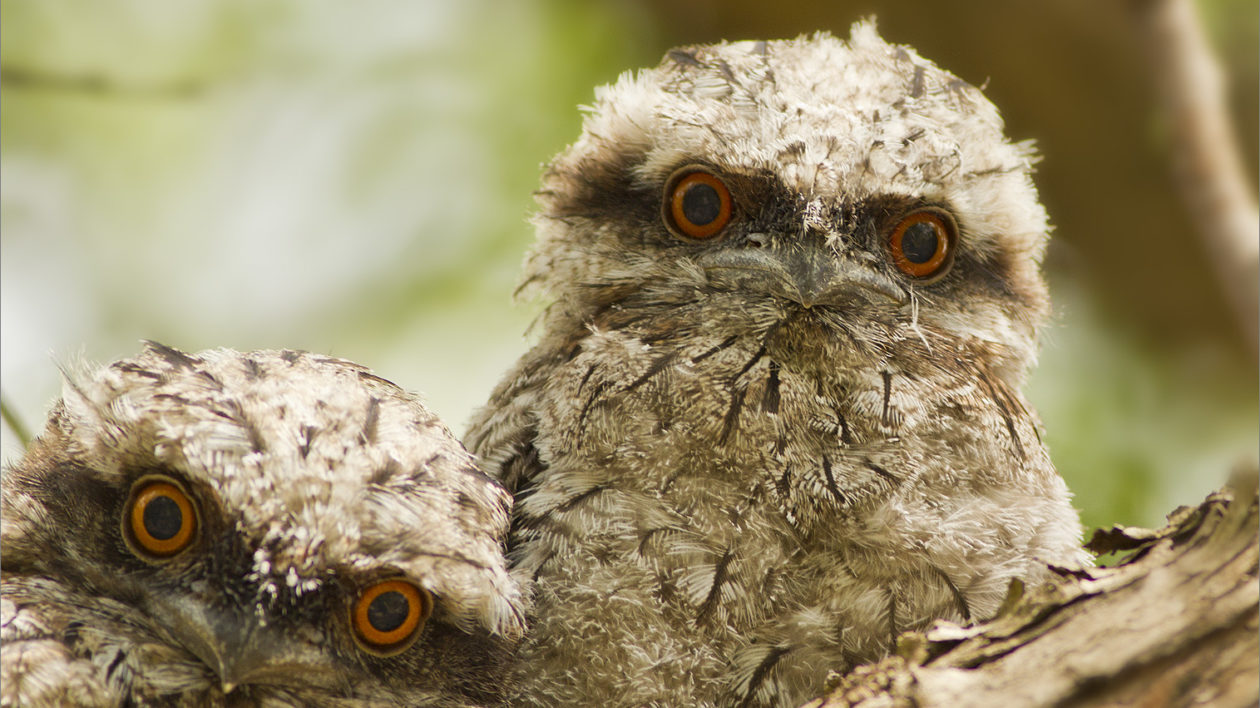
Frogmouths breed each year, raising between one and three chicks in a nest made from a loose pile of sticks jammed into a horizontal, forked branch. It’s not sophisticated, but it gets the job done.
And oh, these chicks. Baby birds look ridiculous, regardless of the species, but frogmouth chicks are a whole other level of hilarious. They look like bedraggled feather dusters on a wild acid trip, their orange-yellow eyes wide in constant surprise.
Tawny frogmouths are one of three species of Australian frogmouths. Eleven other species are found throughout Melanesia, Southeast Asia, and India. Frogmouths have been around for a long time; genetic analysis suggests that the three genera within the frogmouth family diverged from one another between 30 and 40 million years ago.
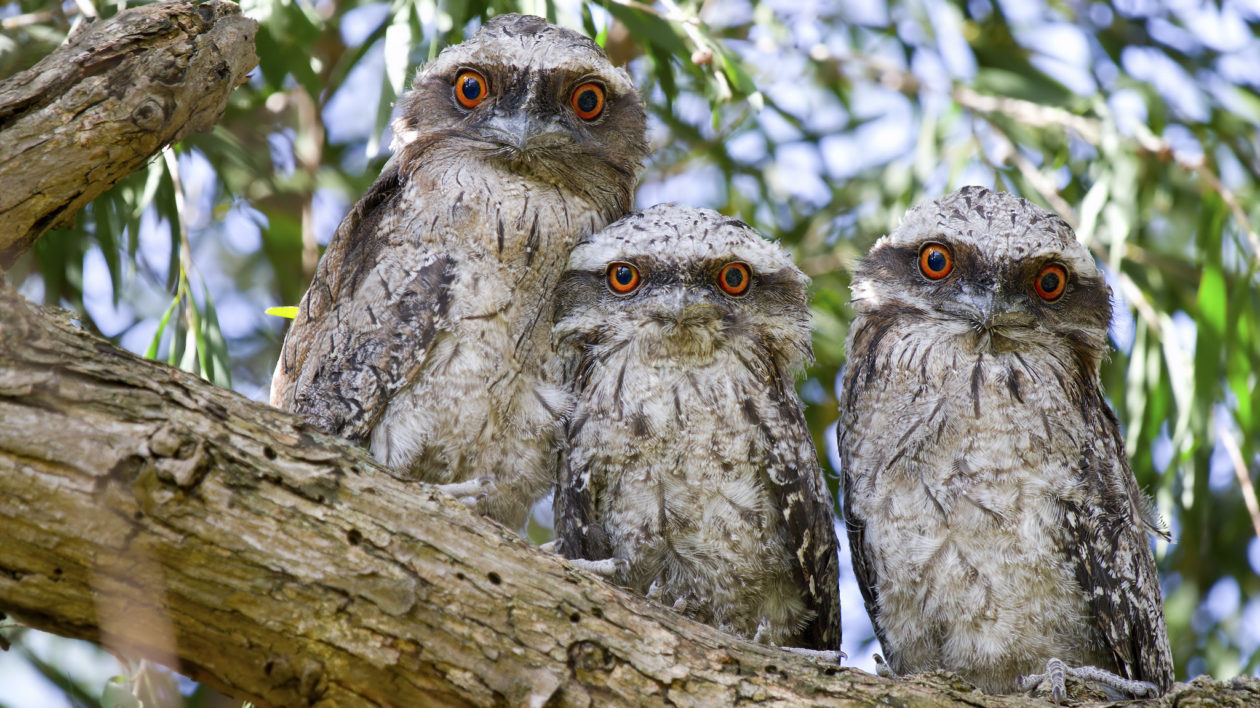
So why, exactly, do I love frogmouths so much?
Perhaps it’s their posture. Anytime they sense activity — a car driving by or jogger on the street — they snap to attention for an Oscar-worthy impression of a tree branch. Body erect, tilted slightly forward. Feathers smoothed down and held close to the body. Beak upright, like a snooty waiter, eyes closed to the thinnest of slits.
I know this because when the workday is done, when I’ve finished sorting through bills or tending to the other odds and ends of life, I drag my chair out to the driveway and sit, facing the house, to watch the frogmouths.
Perhaps my pandemic-addled brain is starved for entertainment. Fair enough. But there’s something about these birds that I find deeply comforting. Their reappearance each morning, always together, at a time when so much is uncertain. Their physical connection, and the comfort it brings them. And even their baleful, grumpy stares, which occur less often these days as we get used to one another.
And so I check for them each morning, watching them through the blinds as my tea brews and the world is quiet for a few more minutes.
Until — oh no — I’m late for my Zoom meeting.




I would not want to get into a stare down contest with these birds….I would lose & quickly so. They are so unique looking. I wonder what they are thinking when those eyes hit yours.
Nature is so much fun to learn of the different “critters” on our planet. I do not believe there is a Mother Nature on a diff planet out there….. that could outdo ours!
Ours is so diverse in wonderment & pure beauty.
Thanks so much for your wonderful presentations & reads about all these animals you write of ; otherwise, most of us would have never learned of their existence.
How blessed am I. I now have a family of 4 living in my strawberry patch. I have placed an old apple crate near them thinking they may use it as it has been raining for 2 days. Do they only use nesting boxes when they are hatching their young?
I love these birds now after reading your article and viewing the photos. So amazing! Do you see them in flight much? If we manage to see an owl in flight it is unusual. But we know they do.
Australia has such unique animals. I doubt I’ll ever get there (age 74) but I do live to see others photos and write-ups.
Thank you for sharing.
How can things be hopeless when there are creatures in the world like these?